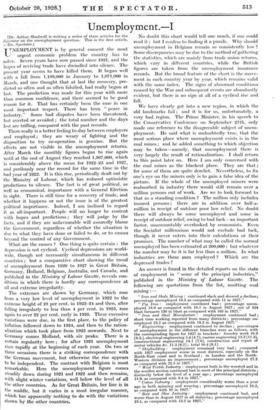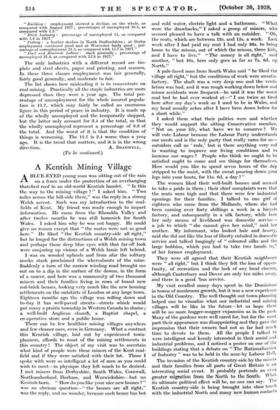Unemployment. —I
[1:)r. Arthur Shadwell is writing a series of three articles for the Spectator on the unemployment question. This is the first article. —ED. Spectator.] UNEMPLOYMENT is by general consent the most ' urgent economic problem the country has to solve. Seven years have now passed since 1921, and the hopes of reviving trade have dwindled into silence. The present year seems to have killed them. It began well with a fall from 1,199,000 in January to 1,071,000 in March, and one thought that -at last the recovery, pre- dicted so often and as often falsified, had really begun at last. The prediction was made for this year with more than common confidence, and there seemed to be good reason for it. That has certainly been the case in one most important respect. There has been " peace in industry." Some bad disputes have been threatened, but averted or avoided ; the total number and the days Jost are trifling, compared with the past records.
There really is a better feeling to-day between employers and employed ; they are weary of fighting and the disposition to try co-operation is genuine. But the effects are not visible in the unemployment returns. After March the monthly figures began to rise again until at the end of August they reached 1,367,000, which is considerably above the mean for 1922-25 and 1927, and perilously near the record for the same time in the bad year of 1922. It is this rise, periodically dealt out by the Ministry of Labour, which has reduced optimistic predictions to silence. The fact is of great political, as well as economical, importance with a General Election in sight. There is still time for a recovery of trade, and whether it happens or not the issue is of the greatest political importance. Indeed, I am inclined to regard it as all-important. People will no longer be content with hopes and predictions ; they will judge by the facts, and if they are unfavourable will assuredly blame the Government, regardless of whether the situation is due to what they have done or failed to do, or to causes beyond the control of any Government.
What are the causes ? One thing is quite certain : the depression is not cyclical. Cyclical depressions are world- wide, though not necessarily simultaneous in different countries ; but a comparative chart showing the trend of unemployment from 1920 to 1927 in Great Britain, Germany, Holland, Belgium, Australia, and Canada, and published in the Ministry of Labour Gazette, reveals con- ditions in which there is hardly any correspondence at all and extreme irregularity.
The extremes are shown by Germany, which rose from a very low level of unemployment in 1922 to the extreme height of 28 per cent. in 1923-24 and then, after falling irregularly to less than 4 per cent. in 1925, rose again to over 22 per cent. early in 1926. These excessive variations were due, in the first place, to the policy of inflation followed down to 1924, and then to the ration- alization which took place from 1925 onwards. Next to Germany comes Holland, with six peaks. There is a certain regularity here ; for after 1921 unemployment rises rapidly at the beginning of each year. On two or three occasions there is a striking correspondence with the German movement, but otherwise the rise appears to be independent. The contrast with Belgium is most remarkable. Here the unemployment figure comes steadily down during 1921 and 1922 and then remains, with slight winter variations, well below the level of all the other countries. As for Great Britain, her line is in the middle, but it varies in a most irregular manner, which has apparently nothing to do with the variations shown by the other countries. No doubt this chart would tell one much, if one could read it ; but I confess to finding it a puzzle. Why should unemployment in Belgium remain so consistently low ? Some discrepancies may be due to the method of gathering the statistics, which are mainly from trade union returns, which vary in different countries, while the British figures are taken from the unemployment insurance records. But the broad feature of the chart is the move- ment in each country year by year, which remains valid with the same index. The signs of abnormal conditions caused by the War and subsequent events are abundantly evident, but there is no sign at all of a cyclical rise and fall.
We have clearly got into a new region, in which the old landmarks fail ; and it is for us, unfortunately, a very bad region. The Prime Minister, in his speech to the Conservative Conference on September 27th, only made one reference to the disagreeable subject of unem- ployment. He said what is undoubtedly true, that the most serious place where unemployment exists is in the coal mines ; and he added something to which objection may be taken—namely, that unemployment there is very largely the result of rationalization. I shall return to this point later on. Here I am only concerned with the coal mines as the blackest place. They are that ; for some of them are quite derelict. Nevertheless, to fix one's eye on the miners only is to gain a false idea of the picture. If the whole of the unemployed miners were reabsorbed in industry there would still remain over a million persons out of work. Are we to look forward to that as a standing condition ? The million only includes insured persons ; there are in addition over half-a- million in receipt of outdoor poor law relief. No doubt there will always be some unemployed and some in receipt of outdoor relief, owing to bad luck—an important factor, unaccountably overlooked by economists. Even the Socialist millennium would not exclude bad luck, though it never enters into their calculations or their promises. The number of what may be called the normal unemployed has been estimated at 200,000 ; but whatever the number may be it is far less than a million. In what industries are these men employed ? Which are the depressed trades An answer is found in the detailed reports on the state of employment in " some of the principal industries," published in the Ministry of Labour Gazette. The following are quotations from the list, omitting coal mining :— " Iron and Shale Mining : continued slack and showed a decline; percentage unemployed 14.3 as compared with 11 in 1927." Pig Iron : employment continued bad ; percentage unem- ployed 18.9 as compared with 16.5 in August 1927 ; out of 424 blast furnaces 130 in blast as compared with 165 in 1927." " Iron and Steel Manufacture : employment continued bad ; short time working reported from many districts ; percentage un- employed 23.2 as compared with 18.3 in August 1927." Engineering : employment continued to decline ; percentages of unemployment in the different branches were as follows, with the corresponding figure for 1927 in brackets : foundry work 10.3 [9.3.], electrical engineering 5.4 [4.7], marine engineering 13.3 [11.3], constructional engineering 14.1 [7.6], construction and repair of motor vehicles &c. 11.3 [9.2] ; total 10.4 [9.1].
" Shipbuilding : employment remained very bad ; compared with 1927 employment worse in most districts, especially on the North-East coast and in Scotland ; in London and the North- Western division an improvement ; percentage unemployed 27.2 as compared with 22.5 in 1927." " Wool Textile Industry : employment both in the worsted and in the woollen section continued bad in most of the principal districts ; distinctly below the level of a year ago ; percentage unemployed 14.9, as compared with 9.4 in 1927." " Cotton Industry : employment considerably worse than a year ago in both spinning and weaving ; percentage unemployed 16.2, as compared with 10 in 1927." " Boot and Shoe Industry : employment continued bad, and worse than in August 1927 in all districts ; percentage unemployed 19.1, as compared with 13.2 in 1927.- - " Building : employment showed a decline, on the whole, as compared with August 1927 ; percentages of unemployed 10.5, as compared with 7.3." " Brick Industry : percentage of unemployed 11, as compared with 5.4 in 1927.
" Pottery : a further decline in North Staffordshire ; at Derby employment continued good and at Worcester fairly i good ; per- centage of unemployment 21.5, as compared with 15.7 n 1927." " Dock and Riverside Labour : slack generally ; percentage of unemployed 31.4, as compared with 22.9 in 1927.'
The only industries with a different record are tin- plate and steel sheets, paper and printing, and seamen: In these three classes employment was fair generally, fairly good generally, and moderate to fair.
The list shows how misleading it is to concentrate on coal mining. Practically all the staple industries are more depressed than they were a year ago. The total per- centage of unemployment for the whole insured popula- tion is 11.7, which. may fairly be called an enormous figure in this period of peace in industry. It is made up of the wholly unemployed and the temporarily stopped, but the latter only account for 3.4 of the total, so that the wholly unemployed represent a percentage of 8.3 of the total. And the worst of it is that the condition of things is worsening. The 11.7 is 2.4 worse than a year ago. It is the trend that matters, and it is in the wrong direction. A. SHADWELL.
(To be continued.)































































 Previous page
Previous page